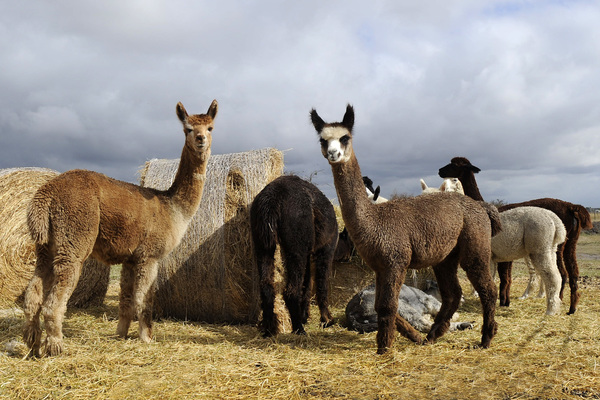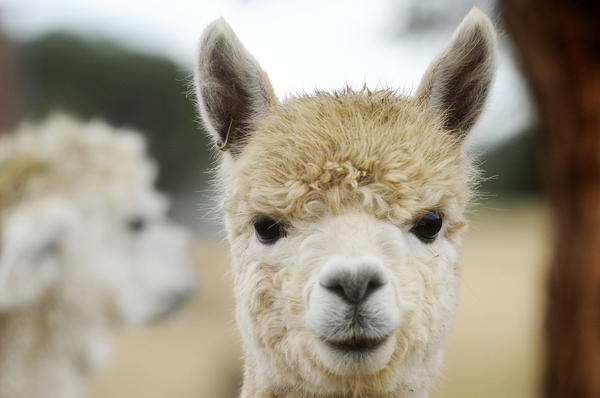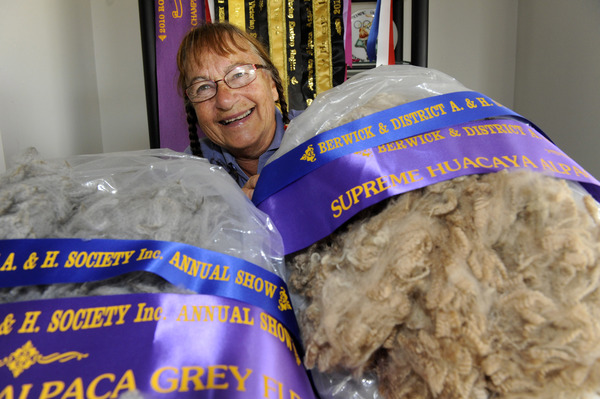
PRECEDE:
Their large, expressive eyes, and shaggy heads can win over hearts easily. Joy Skinner, who runs up to 100 alpacas, talks to BRENDAN REES about her addiction with breeding the friendly animal on her farm, Almora Aplacas.
PULL QUOTE:
“They’re very easy for women to handle because of their size and nature so that’s why a lot of women have them.”
It is an overcast autumn’s morning in Clyde where grey clouds blanket the sky and a few magpies sing in unison from some nearby eucalypt trees.
Joy Skinner walks from the front of her home, wearing a blue polo shirt, navy track pants and boots. Her hair is tied in two plaits, and she has a generous smile.
Only metres away from her home, a group of alpacas who are busily tucking into some hay, spot Joy. Fleecy heads turn, ears prick up and dozens of large, expressive eyes are fixed on her arrival.
“I’ve just fed them, says Joy. “I’ve got a boy over there who wants to mate them, that’s why he’s singing at them,” she says, pointing to a group of female alpacas eating hay in front of a large shed while ignoring the male’s orgling sound.
Joy is the owner of the 20-acre stud farm called Almora Alpacas where she has about 100 Huacaya alpacas. “I just love having them around. I’m addicted to them,” she laughs.
“It’s a paying hobby. It’s a small business through selling animals mainly. I rent them out to guard sheep, and I sell the fleece, and do matings,” she says.
“They’re very easy for women to handle because of their size and nature so that’s why a lot of women have them,” she adds.
All her alpacas are of different genders, ages and colours. “I breed all colours. A lot of people think say you can predict it but I don’t, I’m not so sure about that. You can to a point.
“I mainly concentrate on breeding greys, but they’re one of the hardest colours to breed in my opinion,” she says.
A couple of young alpacas stand on top of a nearby mound of mulch. “They love hills, standing up on hills and surveying the scene, she says. “That’s why I’ve got a few out in the paddock.”
Joy has been running the farm since 1994 which adds to her income as a part-time employee at Woolworths in Berwick.
“It’s an interesting industry to be in I find,” she says. “A lot of breeders that have them commercially have big flocks and they concentrate on making money and selling them for meat and all that. I’m not that sort of person.”
Alpacas can be bred at any time of year, she says. “I concentrate on autumn births a few spring/summer births.”
A deep tone screech suddenly erupts in the distance. After querying what the sound is, Joy says: “It’s a baby and her mum in the shed.” The baby, she adds, was born just the day before. “I can let her out, I can put her in the yard,” she says.
“(I had) two born yesterday while I was out,” she says, whilst walking towards the shed. “I’ve had a good run of girls this season, it’s been really good.”
She says they always give birth while she’s not around. “It’s fairly hard to catch them actually having them.”
“I only put the one in the shed last night when I went to work because it was sunny and she was laying out in the sun and I don’t like that so I popped her in the shed.”
The screeching becomes more pronounced as Joy walks into the opened shed. Hay is strewn across the floor; a tractor parked in the rear corner and large storage bags piled next to each on the other side.
“Hang on a minute,” Joy says. She opens a gate. A white alpaca comes out followed by a black alpaca. Next is Joy, cradling the newborn black alpaca.
“So this is a yesterday one,” she says, with a gleam of excitement in her eye. The mum continues to squeal. “She thinks you might have her,” she tells me. “Come on, I’ll put her out here.”
Mum searches the shed frantically for her baby. “Here, come on,” Joy says to her. “Come over here.”
Joy walks from the shed to a nearby paddock yard. “Keep coming,” she says to the mother, before putting them in the enclosure and closing the gate. The mother keeps screeching. “She’s paranoid isn’t she?” Joy laughs. “Don’t you take my baby away.”
“Now that the baby is out, talking to her, so she gets to know that’s mum in the big herd.”
Joy rests her arm on top of the gate. The white alpaca from the shed has followed Joy and stands beside her. He gazes at her from under his bushy eyebrows.
His name is Beau. “That’s my pet one,” she says. “You’ve got stuff all over you Beau,” as she brushes his back with her hand. “He is really, really quiet,” she laughs.
“I hand raised this one because his mum doesn’t want to be a mum,” she adds, stroking his neck.
She says a lot goes into raising healthy alpacas. “I inoculate them at shearing time. I worm them; give them vitamin D twice a year.” There’s also general husbandry such as checking their eyes and teeth.
The herd are drinking quite a lot of water because of the dry weather, Joy says. “I think it’s the second driest year since I’ve been here.”
She says the alpacas get on well as a group and hardly spit. “It’s a bit of a fallacy that they spit for no reason. There’s some that do it a bit more than others. Some of them will never spit at you at all,” she says, looking out into the horizon.
“They don’t bite and they very rarely kick,” she adds.
The mother of the newborn is still squealing in the paddock. “She’s quite noisy,” Joy says. “She’s a good mum, good mum, very attentive. Some are more vocal than others.”
A brown alpaca, named Foxy Socks, peers into the enclosure while the mother of the newborn walks over to her. “She’s telling the other one to get away from my baby. That’s mine, leave her alone, don’t be a stickybeak.”
Joy says they all have different personalities. “Every single one of them. They’re all different. They’re amazing.”
Asked what continues to drive her in breeding alpacas, Joys says with a laugh: “I just love the babies. Definitely, definitely babies for me.”











